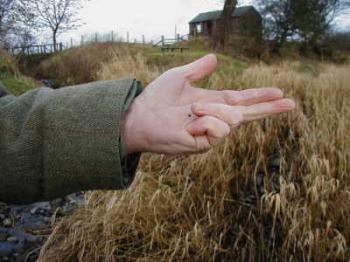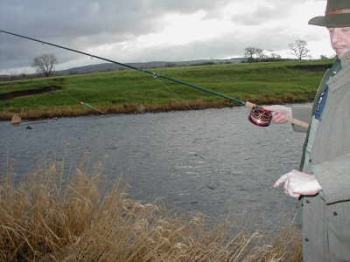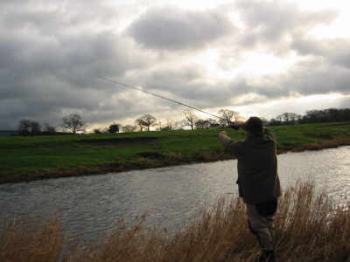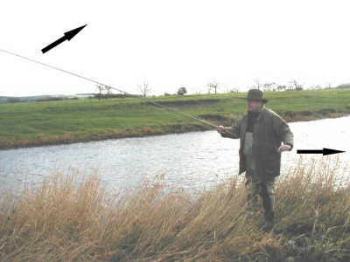The use of the reel was first referred to in English angling literature in Thomas Barker’s The Art of Angling (1651). However for our purpose, the modern centerpin action reel was invented by Henry Coxon around the turn of the last century – this reel was to evolve into the Alcocks Aerial. This reel was a massive improvement on all that had gone before it.
The basic principle of the reel revolving on a tiny bearing surface where the tip of the centerpin has contact with a central adjusting screw was a stroke of genius. It allowed anglers to fish with finer tackle than they had been previously able to, and in the right hands they could also be used to cast considerable distances. To manage this casting required an element of skill.
Subsequently, the development and increased availability of the fixed spool reel allowed anglers to abandon these skills in favour of the easy long distance casting that the fixed spool reel offers and for many years centerpin reels fell out of favour with the general angling public.
Today, this situation has changed and many anglers are rediscovering that the centerpin, when used in the right circumstances, can be much more efficient that the fixed spool reel. More to the point, they can be a lot more fun to use. Controlling a float when trotting and playing fish directly without gears in the way are two of the lovely experiences that the centerpin offers.
Buying A Centerpin
There are a number of good centerpins on the market nowadays, though the price of some of them can be a bit thought provoking! Mind you, a good centrepin reel is a lifetime investment.
Probably the best known manufacturer is J.W.Youngs of Redditch who make several different ranges of centerpins which are marketed under their own name and the names of other well known tackle firms. The quality of this firms’ products is superb and the after sales and spares service is exemplary. You can still get spare parts for their centerpins that they made 30 years ago!
For those who are mesmerised by the price of the new reels, you can get them second hand and major savings can be made. Old “Trudex’s” are presently changing hands at around £30-45. These are perfectly serviceable reels and represent good value.(Editor’s note: visit www.centre-pin.co.uk for a vast range of secondhand centrepin reels)
When buying a reel, take no notice of the sellers usual comments of “It’ll spin forever, mate” as this is no indication as to the worth of the reel. Far more important is how little weight it takes to set it running. Overcoming inertia is more important than flywheel effect.
Check to see if the reel spins smoothly without excessive wobble and check to makes sure that the ratchet engages smoothly, both on and off. Look at the overall condition of the reel, including any visible screw heads and make sure that they are not chewed up.
Make sure that the ratchet bias is either set the way you want it or is easily reversible……then haggle!
If the reel has been made by J.W.Youngs, then there should be little problem getting spares. Care should be taken with reels from other manufacturers as spares may be harder to come by.
In recent years, a number of other companies have come into the centerpin market. These include Hardy Greys, who currently have a couple of ‘pins in their range. The first is the Conquest, which I have some doubts about and the second is the Bewick. This reel is now in its Mark Two guise and is much improved on the original. Out of the two, it is my personal choice and it has the advantage of being about half the price of the Conquest.
Another major new player in the field is Okuma. This firm now produce a range of pins based around the VT1002 Adventa Pro. This really is a first class workhorse of a reel and one I wholeheartedly recommend. They do a prettier version known as the Sheffield. Another version is the Kennet – this reel has a built in line guard. However, I have reservations about line guards in general and this one in particular as it prevents retrieving the line by batting the spool. They currently produce a version with a built in star drag called the Trent.
A company who have been producing centerpins for years is Lewthwaite engineering. They have quite a range, starting with the cheaper Leeds reels and moving on to their higher quality Magnum Range.
For those who want to buy an heirloom, there are still some small artisan made reels with Chris Lythe being the best known maker.
Plain Bearing Or Ball Bearing?
Reels that are completely dependant on ball bearings for their action are not true centerpins in the absolute sense. They are technically drum reels, but none the worse for it. The advantage of this type of reel over a true centerpin is that they can be used with the reel hanging vertically beneath the rod with the handles pointing to either the right or the left. Many anglers feel more comfortable fishing in this manner when trotting.
The true centerpin needs to be held horizontally with the handles pointing skywards to utilise the bearing to its best advantage. This can take a little getting used to at first, but soon becomes second nature.
Where the true centerpin has an advantage over the ball bearing variety is when the angler wishes to use the ‘Wallis’ style of casting, as there is much less frictional inertia to overcome at the start of the cast.
Caged Drum Or Solid Drum?
A caged drum is one where the spool consists of sideplates held in position by riveted bars. The Alcocks Aerial is the best known version of a reel with this style of drum or spool.
A solid drum is one were the spool has been milled out in one piece. The Okuma Advents Pro is a reel of this type, as is the Greys Bewick.
In practical fishing terms, the solid drum is to be preferred, even though is is often slightly heavier as the problem of line bury is vastly reduced, leading to smoother casting and trotting.
New Or Secondhand?
Not too long ago, this wasn’t much of an issue as very few centerpins were being made. Nowadays, there are plenty of first class new ones on the market and if you are new to using centerpins, or are thinking of getting your first, my recommendation would be to go for a new one and leave the secondhand centrepin market to the collectors, certainly until you get to know what you are looking for. Don’t be taken in with the old line “they don’t make them like this anymore,” to which the proper answer should be, “Good!“. Modern CNC milling machines usually turn out a better product!
Sidecast Type Reels
These are reels in which the spool can be turned to face forwards, like a fixed spool reel, and cast in a similar manner. This type of reel gets ‘reinvented’ every few years. They are best avoided, as if you cast with them using the sidecast facility they promote an inordinate amount of line twist.
Loading The Reel
In the normal course of events, I recommend that you load the reel with no more than about fifty yards of line of the chosen strength. The purpose of this is to prevent line ‘bedding in’, which can cause problems when casting from the drum of the reel in the ‘Wallis’ style. For the same reason, spread the line over the whole width of the drum.
I normally recommend that you load the li
ne in such a way as it comes off the bottom of the drum. This is particularly important if you intend to cast in the ‘Wallis’ style.
Casting
Nottingham Style Cast
For the beginner and for certain fishing situations, a simple cast is the order of the day.
To execute this cast the angler simply draws off one or two loops of line from either side of the butt ring and with a forward sweeping motion of the rod casts his tackle out the length of the line that he has drawn off.
This style of casting is fine if all that is needed is short cast and as the same length of line can be drawn off every time it can be a very precise cast. The drawback with this style of cast is that as longer distances are needed so the angler must draw an increasing number of loops of line working up the rings of the rod. Very soon this becomes impractical as well as inelegant!.
The Wallis Cast
Probably the most famous of the great casters with the centerpin was F.W.K.Wallis. This man was, in his time, a colossus who ruled over the Hampshire Avon between the two World Wars. He was a gifted barbel angler and, along with two others, had a barbel of 14lb 6oz to his credit, though the record with a fish of this weight was credited to Aylmer Tyron. Wallis developed a method of casting off the drum of a centerpin which, with a little practice, allowed the angler to cast with comparatively light tackle up to thirty and more yards.
In describing this cast, I am going to assume that the angler is using float tackle and, as is common with this sort of set up, has a tell tale shot set around 4″ to 9″ away from the hook.
For a right handed angler he should, in the first instance, be stood facing either up stream or down stream, whichever gives him best advantage.
The reel should be placed in the normal place on the rod butt near the top of the butt. The rod should be held so that the handles of the reel face upwards. The right hand should hold the rod close to the reel, so that the thumb of the right hand rests on the rim of the spool of the reel.
The line from the tip ring of the rod should be long enough to allow the angler to be able to comfortably hold the bottom split shot of the rig with the left hand. This should be held by lightly trapping the shot with the little finger allowing the baited hook to hang free below the hand.
The thumb or the forefinger of the left hand should be placed in the loop of line between the reel and the butt ring and a little line should be drawn off. The amount of this line should be just enough to make the angler feel comfortable.
The angler should bring the rod up to chest height the tip pointing slightly behind him.
The Wallis Cast In Photos
 Shot and hooklength trapped under little finger
Shot and hooklength trapped under little finger
 The starting position of the hands
The starting position of the hands
 The follow through – left hand returns to meet the right
The follow through – left hand returns to meet the right
Now For The Clever Bit!
The cast is made by dropping the shot that has been in the left hand and at the same time sweeping the rod forwards and upwards with the right hand to propel the tackle out. Also, at the same time as the rod is being swept forwards, the left hand should be drawn swiftly and smoothly backwards this action causes the loop to grow and sets the reel spinning.
The tackle should now fly out towards the area you wish it to land in. Whilst the tackle is in flight, keeping the line running over the forefinger (or thumb, if used), bring the left hand up to meet the right.
As the tackle lands, stop the spool spinning with the thumb of your right hand. This will prevent overruns.
Hopefully by now you tackle will be sitting prettily just where you want it to be!
Retrieving
Line may be retrieved either by using the handles provided, though some reels have convenient holes in the face of the drum into which you can slip your finger and use that. A faster method of retrieval is by ‘Batting’ the drum of the spool towards you. However, this is only really effective when retrieving tackle at the end of a trot and there is no fish on.
Playing Fish
Pressure can be brought to bear on a running fish by the application of pressure on the edge of the drum of the reel with either the thumb, or if the fish is a really big one, using the palm of the hand instead of the thumb.
Having direct contact allows the angler, with a little practice, to gauge very accurately the optimum pressure that can be applied to a running fish without risking tackle breakages. Fish can usually be brought under control more quickly when using a ‘pin because of the direct contact.
I hope that this short guide will help you enjoy the fun that fishing with the centerpin can provide.
M. A. Roe
For a vast range of centrepin reels for sale, please visit
www.centre-pin.co.uk
























